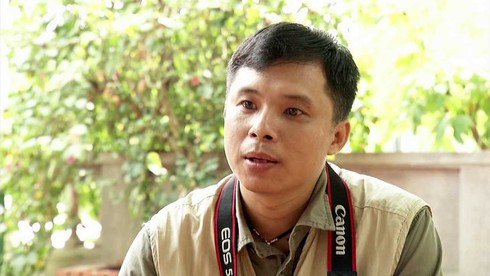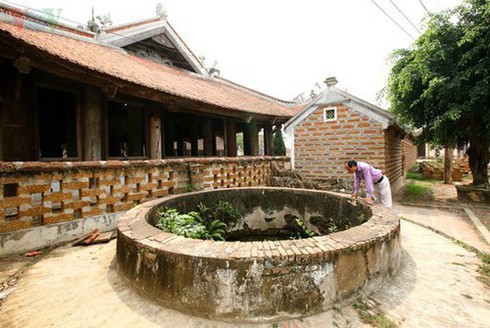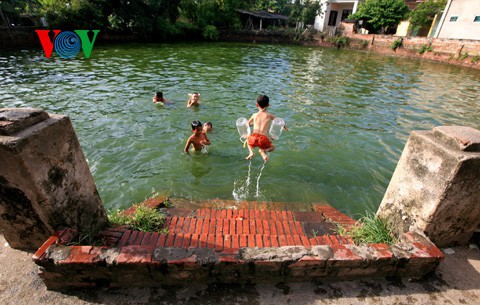 |
| Photographer Le Bich (Photo: qpvn.vn) |
A village well doesn’t just provide water for the villagers’ daily use. It has a spiritual significance in the village’s culture. In this week’s Village Life, photographer Le Bich, who has visited 200 villages and photographed 300 wells will talk to us about communal wells.
During his many trips to northern villages to photograph traditional crafts and craftsmen, Hanoi native Le Bich learned that water wells in different shapes have different meanings.
A square well represents Mother Earth; a round well symbolizes the sun; an oval well resembles a mirror, reflecting the peaceful daily life of the village.
Some wells are as big as small ponds surrounded by walls made of earth, stone, or laterite bricks. Other wells, called earthen wells, have no walls.
 |
| The well of Mong Phu Communal House in Duong Lam ancient village, 40km to the west of Hanoi (Photo: Le Bich/VOV) |
A village well is a place to meet, gossip, and flirt. In some places, the locals take water from the communal well and dedicate it to the village tutelary god.
“Old people attach great importance to the village well and its spiritual values. They consider the communal well a place that collects the village’s happiness and virtue and links the heaven and the earth with humans,” said Le Bich.
He added, “A long time ago, when people didn’t have water piped into each home, well water was a godsend which had to be allocated fairly. Communal wells remind young people of their native land, ancestors, and childhood.”
Bich says he loves rural villages, where wells still have an important role in people’s social life and represent a village’s source of vitality.
That’s why he has taken photos of rural wells and the daily activities around the wells, and has recorded many related stories.
According to Bich, “The well in Dan village, which is now Xuan Dinh commune in Hanoi, home to many Cham ethnic people, is considered sacred. During the village festival in the second lunar month, villagers gather by the well to conduct a ritual that involves a procession, ancient dances, and a ‘sinh tien’ dance, a traditional dance of many northern villages.”
“After the ceremony, old villagers use folded areca spatheto take water from the well and put it in an ornamental jar which two young people carry to the communal house. On the way, the young people drop into one house or another. Villagers hope they will come to their house because the jar of water represents good luck,” said Bich.
Since 2010 Bich has visited some 200 villages nationwide and photographed 300 ancient wells. What attracts Bich most is the spiritual significance of the wells. The more he studies them, the more he is impressed by their intrinsic beauty.
Bich said, “The well has different layers of culture. In the first 5 years, I only studied wells in the northern region. There are deep wells, earthen wells, surface well, and horizontal wells. But people in the central region have a different concept of a well. Well water is not ground water but comes from a hill or mountain slope."
"The well in Gio Linh, Quang Tri province, is another special case. It is made of rocks placed on each other without cement. Its water is stratified. The water on the top level is used for worshipping. Villagers are only allowed to use the water on the second level for daily activities. The water on the third floor is for bathing children or feeding cows and buffaloes. Water from a gutter is used for irrigation,” he added.
 |
| An ancient well in Nghiem Xuyen, Hanoi’s outlying district of Thuong Tin, has turned into a swimming pool (Photo: Le Bich) |
Bich says he has followed with keen interest on the way people treated the wells, adding, “I find that many wells are being “betrayed”. In some places, the wells have been filled in to build roads. In other places, the wells have become stagnant.”
He said, “But there are still villages where the locals care about their wells and donate money to rebuild them. Sometimes villages assign people to guard their wells. On a full moon day or the first day of a lunar month, villagers burn incense at a well shrine. Generally speaking, most Vietnamese still respect their village well."
Le Bich says he hopes his photos will encourage people to take responsibility for protecting rural wells from social change.VOV5
 Almost every village in Vietnam has at least one well, an indispensable part of the classic Vietnamese rural tradition of banyan tree, well, and communal house yard.
Almost every village in Vietnam has at least one well, an indispensable part of the classic Vietnamese rural tradition of banyan tree, well, and communal house yard.